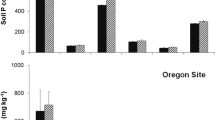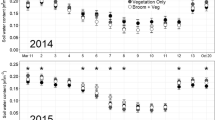Abstract
Recovery of ecosystem properties following removal of invasive plants likely varies with characteristics of the plant and the relative soil quality at a given site. These factors may influence the occurrence of soil legacies and secondary invasions, hindering the effectiveness of restoration strategies. We assessed the potential for ecosystem recovery following removal of N-fixing Scotch broom for 4 years at two sites that contrasted strongly in soil quality in western Washington and Oregon, USA. Comparisons were made among plots, where Scotch broom was never present (uninvaded), retained, or removed. Scotch broom removal increased PAR and soil temperature but had limited effects on soil moisture. Concentrations of soil Ca, Mg, K, and P were significantly lower with Scotch broom removal, with the effect being most pronounced at the low-quality site. NMS ordinations indicated that the treatments differed in vegetation composition, with limited recovery following broom removal. Non-native and native species varied inversely in their abundance responses, where non-native species abundance was greatest in the removal treatment, intermediate in the retained treatment, and lowest in the uninvaded treatment, indicating occurrence of a secondary invasion following removal. As with the soil response, effects were more pronounced at the low-quality site. Our findings indicate that Scotch broom removal exacerbates negative effects on soil chemistry and plant communities, with little evidence of recovery over our study period. These findings highlight the importance of controlling Scotch broom invasions immediately after the species establishes, especially on low-quality sites that are more susceptible to Scotch broom invasion.




Similar content being viewed by others
Availability of data and materials
All data associated with this study are available from the corresponding author on reasonable request.
References
Bateman JB, Vitousek PM (2018) Soil fertility response to Ulex europaeus invasion and restoration efforts. Biol Invasions 20:2777–2791. https://doi.org/10.1007/s10530-018-1729-9
Bossard CC, Rejmánek M (1994) Herbivory, growth, seed production, and resprouting of an exotic invasive shrub Cytisus scoparius. Biol Conserv 67:193–200
Caldwell BA (2006) Effects of invasive scotch broom on soil properties in a Pacific coastal prairie soil. Appl Soil Ecol 32:149–152
Carter DR, Slesak RA, Harrington TB, D’Amato AW (2019a) Effects of irrigation and phosphorus fertilization on physiology, growth, and nitrogen-fixation of Scotch broom (Cytisus scoparius). Plant Physiol Rep. https://doi.org/10.1007/s40502-019-00459-7
Carter DR, Slesak RA, Harrington TB, D’Amato AW (2019b) Comparative effects of soil resource availability on physiology and growth of Scotch broom (Cytisus scoparius) and Douglas-fir (Pseudotsuga menziesii) seedlings. For Ecol Manage. https://doi.org/10.1016/j.foreco.2019.117580
Carter DR, Slesak RA, Harrington TB, Peter DH, D’Amato AW (2019c) Scotch broom (Cytisus scoparius) modifies microenvironment to promote a non-native community structure. Biol Invasions. https://doi.org/10.1007/s10530-018-1885-y
Carter DR, Slesak RA, Harrington TB, D’Amato AW (2021) Soil texture and other site-level factors differentially affect growth of Scotch broom and Douglas-fir seedlings in the western Pacific Northwest. Can J for Res. https://doi.org/10.1139/cjfr-2021-0011
Corbin JD, D’Antonio CM (2012) Gone but not forgotten? Invasive plants legacies on community and ecosystem properties. Invasive Plant Sci Manage 5:117–124
Czortek P, Królak E, Borkowska L, Bielecka A (2020) Impacts of soil properties and functional diversity on the performance of invasive plant species Solidago canadensis L. on post-agricultural wastelands. Sci Total Environ. https://doi.org/10.1016/j.scitotenv.2020.139077
D’Antonio CM, Ostertag R, Cordell S, Yelenik S (2017) Interactions among invasive plants: lessons from Hawaii. Annu Rev Ecol Evol Syst 48:521–541. https://doi.org/10.1146/annurev-ecolsys-110316-022620
Dassonwille N, Vanderhoven S, Vanparys V, Hayez M, Gruber W, Meerts P (2008) Impacts of alien invasive plants on soil nutrients are correlated with initial site conditions in NW Europe. Oecologia 133:206–214
Egunjobi J (1971) Ecosystem Processes in a Stand of Ulex Europaeus L.: I. Dry matter production, litter fall and efficiency of solar energy utilization. J Ecol 59(1):31–38. https://doi.org/10.2307/2258449
Fogarty G, Facelli JM (1999) Growth and competition of Cytisus scoparius, an invasive shrub, and Australian native shrubs. Plant Ecol 144:27–35
Grove S, Parker IM, Haubensak KA (2015) Persistence of a soil legacy following removal of a nitrogen-fixing invader. Biol Invasions 17:2621–2631
Halverson NM, Topik C, Van Vickle R (1986) Plant association and management guide for the western hemlock zone. Mount Hood National Forest. USDA Forest Service. Pacific Northwest Region, Portland, pp 62–65
Harrington TB, Schoenholtz SH (2010) Effects of logging debris treatments on five-year development of competing vegetation and planted Douglas-fir. Can J for Res 40:500–510
Harrington TB, Peter DH, Slesak RA (2018) Logging debris and herbicide treatments improve growing conditions for planted Douglas-fir on a droughty forest site invaded by Scotch broom. For Ecol Manage 417:31–39
Harrington TB, Slesak RA, Dollins J, Schoenholtz SH, Peter D (2020) Logging- debris configuration and vegetation control influence 15-year changes in soil C and N and stand characteristics of planted coast Douglas-fir in western Washington and Oregon. For Ecol Manage. https://doi.org/10.1016/j.foreco.2020.118288
Haubensak KA, Parker IM (2004) Soil changes accompanying invasion of the non-native shrub Cytisus scoparius in glacial outwash prairies of western Washington [USA]. Plant Ecol 175:71–79
Henderson JA, Peter DH, Lesher RD, Shaw DC (1989) Forested plant associations of the Olympic national forest. USDA Forest Service Report No. R6-ECOL-TP 001–88, pp 350–353
Kettenring KM, Adams CR (2011) Lessons learned from invasive plant control experiments: a systematic review and meta-analysis. J Appl Ecol 48:970–979
Kuebbing SE, Nunez MA (2015) Negative, neutral, and positive interactions among non-native plants: patterns, processes, and management implications. Glob Change Biol 21:926–934
Lázaro-Lobo A, Ramirez-Reyes C, Lucardi RD, Ervin GN (2021) Multivariate analysis of invasive plant species distributions in southern US forests. Landscape Ecol 36:3539–3555. https://doi.org/10.1007/s10980-021-01326-3
Maron JL, Jefferies RL (1999) Bush lupine mortality, altered resource availability, and alternative vegetation states. Ecology 80(2):443–454
McCune B, Mefford MJ (2018) PC-ORD. Multivariate Analysis of Ecological Data. Version 7.08
McCune B, Grace JB, Urban DL (2002) Analysis of Ecological Communities. MjM Software Design, Gleneden Beach
McGeoch MA, Genovesi P, Bellingham PJ, Costello MJ, McGrannachan C, Sheppard A (2016) Prioritizing species, pathways, and sites to achieve conservation targets for biological invasion. Biol Invasions 18:299–314. https://doi.org/10.1007/s10530-015-1013-1
Montagnini F, Haines B, Swank WT (1991) Soil solution chemistry in black locust, pine/mixed-hardwoods and oak/hickory forest stands in the southern Appalachians, USA. For Ecol Manage 40:199–208
Nisikani MM, van Wilgen BW, Gaertner M (2018) Barriers to ecosystem restoration presented by soil legacy effects of invasive alien N2-fixing woody species: implications for ecological restoration. Restor Ecol 26:235–244. https://doi.org/10.1111/rec.12669
Parker IM, Harpole W, Dionne D (1997) Plant community diversity and invasion of the exotic shrub Cytisus scoparius: testing hypotheses on invasibility and impact. In: Dunn PV, Ewing K (eds) Ecology and conservation of the Southern Puget Sound Prairie Landscape The Land Conservancy. Seattle, Washington, pp 149–161
Potter KJB, Kritcos DJ, Watt MS, Leriche A (2009) The current and future potential distribution of Cytisus scoparius: a weed of pastoral systems, natural ecosystems and plantation forestry. Weed Res 49:271–282
Prior KM, Adams DC, Klepzig KD, Huler J (2018) When does invasive species removal lead to ecological recovery? Implications for management success. Biol Invasions 20:267–283
PRISM Climate Group (2012) PRISM (Parameter-elevation regressions on independent slopes model) climate mapping system. Oregon State University. http://prism.oregonstate.edu
Reid AM, Morin L, Downey PO, French K, Virtue JG (2009) Does invasive plant management aid the restoration of natural ecosystems? Biol Conserv 142(10):2342–2349
Richardson B, Whitehead D, McCracken IJ (2002) Root-zone water storage and growth of Pinus radiata in the presence of a broom understorey. N Z J for Sci 32(2):2008–2220
SAS Institute Inc. (2013) The SAS System for Windows, version 9.4. Cary, North Carolina
Shaben J, Myers JH (2010) Relationships between Scotch broom (Cytisus scoparius), soil nutrients, and plant diversity in the Garry oak savannah ecosystem. Plant Ecol 207:81–91. https://doi.org/10.1007/s11258-009-9655-7
Simberloff D, Parker IM, Windle PN (2005) Introduced species policy, management, and future research needs. Front Ecol Environ 3(1):12–20. https://doi.org/10.1890/1540-9295(2005)003[0012:ISPMAF]2.0.CO;2
Slesak RA, Scheonholtz SH, Harrington TB, Strahm BD (2009) Dissolved carbon and nitrogen leaching following variable logging-debris retention and competing vegetation control in Douglas-fir plantations of western Oregon and Washington. Can J for Res 39:1484–1497
Slesak RA, Harrington TB, D’Amato AW (2016) Invasive Scotch broom alters soil chemical properties in Douglas-fir forests of the Pacific Northwest, USA. Plant Soil 398:281–289. https://doi.org/10.1007/s11104-015-2662-7
Slesak RA, Harrington TB, D’Amato AW, Carter DR (2021) Legacy effects of non-native Cytisus scoparius in glacial outwash soils: Potential impacts to forest soil productivity in western Washington. For Ecol Manage 481(2):1–8. https://doi.org/10.1016/j.foreco.2020.118733
Soil Survey Staff, USDA-NRCS. 2021. Official soil series descriptions. Available from https://www.nrcs.usda.gov/wps/portal/nrcs/detail/soils/survey/geo/?cid=nrcs142p2_053587 [accessed March 3, 2021].
The PLANTS database, 2018. USDA Nat. Resour. Conserv. Serv. <http://plants.usda.gov>
Van Miegrot H, Cole DW (1984) The impact of nitrification on soil acidification and cation leaching in a red alder ecosystem. J Environ Qual 13:586–590
Walker LR, Vitousek PM (1991) An invader alters germination and growth of a native dominant tree in Hawai’i. Ecology 72:1449–1455
Waterhouse BM (1988) Broom (Cytisus scoparius) at Barrington Tops, New South Wales. Aust Geogr Stud 26:239–248
Watt MS, Whitehead D, Mason EG, Richardson B, Kimberly MO (2003a) The influence of weed competition for light and water on growth and dry matter partitioning of young Pinus radiata, at a dryland site. For Ecol Manage 183:363–376
Watt MS, Clinton PW, Whitehead D, Richardson B, Mason EG, Leckie AC (2003b) Above-ground biomass accumulation and nitrogen fixation of broom (Cytisus scoparius L.) growing with juvenile Pinus radiata on a dryland site. For Ecol Manage 184:93–104
Wearne LJ, Morgan JW (2004) Community-level changes in Australian subalpine vegetation following invasion by the non-native shrub Cytisus scoparius. J Veg Sci 15:595–604
Weidenhamer JD, Callaway RM (2010) Direct and indirect effects of invasive plants on soil chemistry and ecosystem function. J Chem Ecol 36:59–69
Williamson J, Harrison S (2002) Biotic and abiotic limits to the spread of exotic revegetation species. Ecol Appl 12:40–51. https://doi.org/10.1890/1051-0761(2002)012[0040:BAALTT]2.0.CO;2
Yelenik SG, Stock WD, Richardson M (2004) Ecosystem level impacts of invasive Acacia saligna in the South African Fynbos. Restor Ecol 12(1):44–51. https://doi.org/10.1111/j.1061-2971.2004.00289.x
Acknowledgements
Financial support for this research was provided by the USDA National Institute for Food and Agriculture (Grants.gov number: GRANT11325729) and by the USDA Forest Service, Pacific Northwest Research Station. We thank Port Blakely and Green Diamond Resource Company for use of their land and logistical support. Thanks also to James Dollins for assistance with the field work.
Author information
Authors and Affiliations
Contributions
RAS, TBH, and AWD conceived and designed the experiment. TBH and DHP collected the data. RAS and TBH analyzed the data. RAS wrote the manuscript, and all other authors reviewed the paper and provided editorial comment. All authors approved of the final manuscript.
Corresponding author
Ethics declarations
Conflict of interest
The authors declare that they have no known competing financial interests or personal relationships that could have appeared to influence the work reported in this paper.
Additional information
Communicated by Jennifer Funk.
Supplementary Information
Below is the link to the electronic supplementary material.
Rights and permissions
About this article
Cite this article
Slesak, R.A., Harrington, T.B., D’Amato, A.W. et al. Removal of invasive Scotch broom increases its negative effects on soil chemistry and plant communities. Oecologia 198, 243–254 (2022). https://doi.org/10.1007/s00442-021-05099-z
Received:
Accepted:
Published:
Issue Date:
DOI: https://doi.org/10.1007/s00442-021-05099-z




